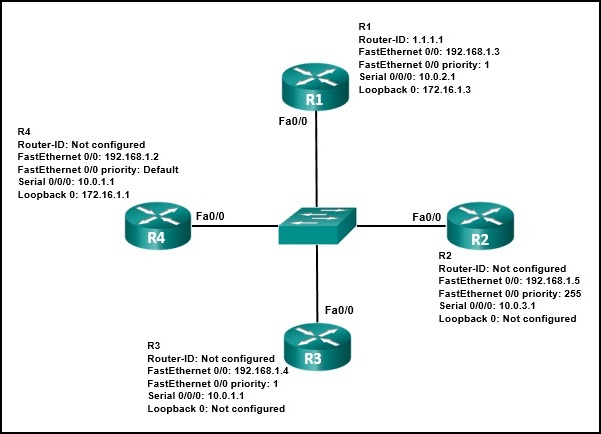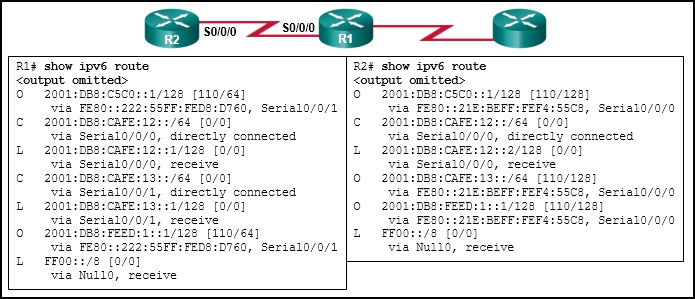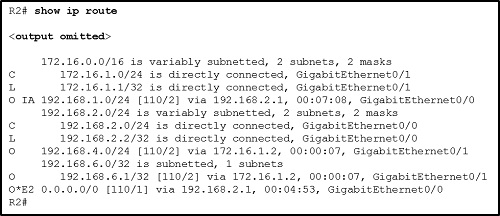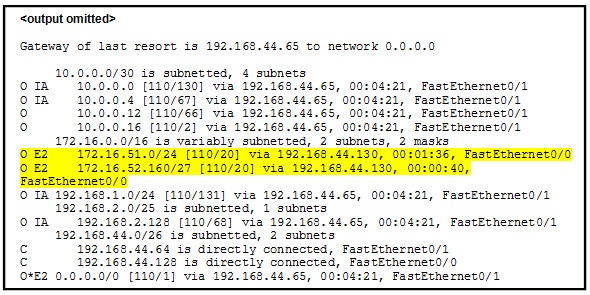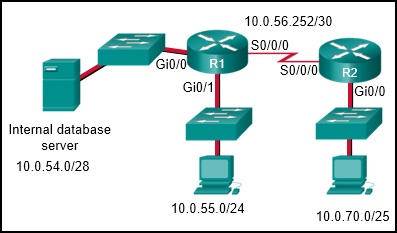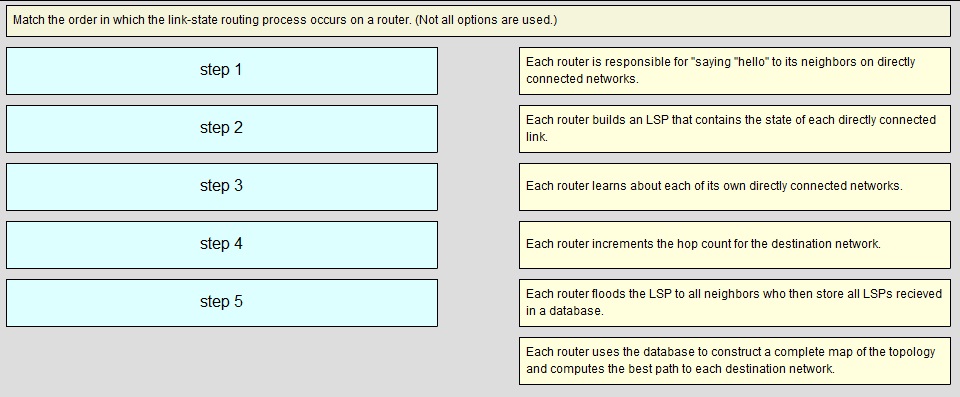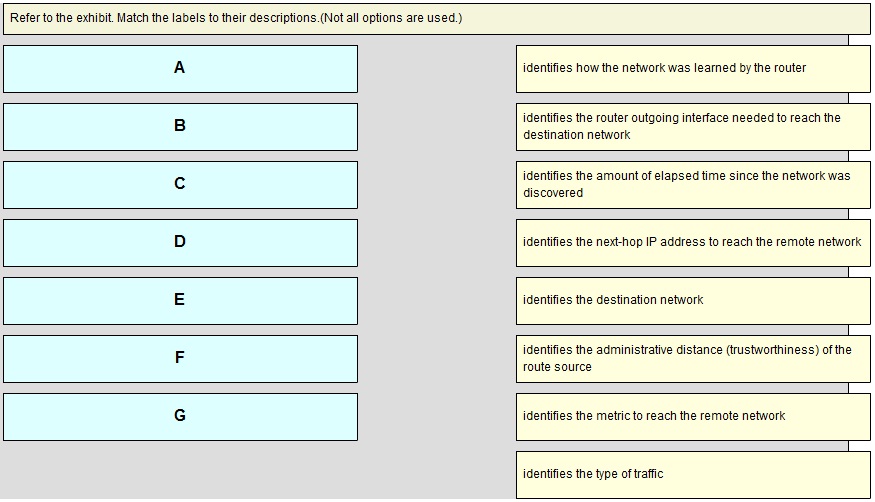CCNA 5.0 (CCNA R&S) – Routing Protocols Final Exam P2
31
Which three requirements are necessary for two OSPFv2 routers to form an adjacency? (Choose three.)
The two routers must include the inter-router link network in an OSPFv2 network command.
The OSPFv2 process is enabled on the interface by entering the ospf process area-id command.
The OSPF hello or dead timers on each router must match.
The OSPFv2 process ID must be the same on each router.
The link interface subnet masks must match.
The link interface on each router must be configured with a link-local address.
32
How is the router ID for an OSPFv3 router determined?
the highest IPv6 address on an active interface
the lowest MAC address on an active interface
the highest IPv4 address on an active interface
the highest EUI-64 ID on an active interface
33
Refer to the exhibit. Which three statements describe the results of the OSPF election process of the topology that is shown in the exhibit? (Choose three.)
R2 will be elected DR.
R1 will be elected BDR.
R3 will be elected BDR.
The R4 router ID is 172.16.1.1.
The R4 FastEthernet 0/0 priority is 128.
The router ID on R2 is the loopback interface.
34
Refer to the exhibit. An administrator has entered the command default-information originate in OSPFv3 global configuration mode on R1, but R2 is not receiving a default route. What is the problem?
OSPFv3 is not running on R2.
R1 and R2 are on different subnets.
R1 does not have a default route configured.
The default-information originate command is only used for OSPFv2.
35
Which two commands will configure OSPFv2 MD5 authentication on a router interface? (Choose two.)
router ospf 10
ip ospf priority 255
default-information originate
area 0 authentication message-digest
ip ospf authentication message-digest
ip ospf message-digest-key 1 md5 CISCO-ABC
36
What are two features of a link-state routing protocol? (Choose two.)
Routers send periodic updates only to neighboring routers.
Routers send triggered updates in response to a change.
Routers create a topology of the network by using information from other routers.
The database information for each router is obtained from the same source.
Paths are chosen based on the lowest number of hops to the designated router.
37
When does an OSPF router become an ABR?
when the router has interfaces in different areas
when the router is configured as an ABR by the network administrator
when the router has the highest router ID
when the router has an OSPF priority of 0
38
Refer to the exhibit. What can be concluded about network 192.168.1.0 in the R2 routing table?
This network has been learned from an internal router within the same area.
This network was learned through summary LSAs from an ABR.
This network is directly connected to the interface GigabitEthernet0/0.
This network should be used to forward traffic toward external networks.
39
Refer to the exhibit. What are two things that are different about the highlighted E2 routes in the routing table? (Choose two.)
These routes were learned using Type 5 LSAs.
These routes have an administrative distance of 20.
These routes can be used as backup default routes.
These routes are used to reach networks outside the OSPF multiarea network.
These routes are networks connected to other routers in the same OSPF area.
These routes are networks contained to other routers in a different OSPF area.
40
Which two OSPFv3 statements are true? (Choose two.)
OSPF networks are configured under router configuration mode.
The multicast address FF02::6 is used to forward packets to the OSPF DR and BDR.
The router ID is configured using an IPv4 address.
The router-id router-id command is issued in interface configuration mode.
The router ospf priority priority command is issued under the router configuration mode.
41
Refer to the exhibit. The R1 router is participating in a multiarea OSPF network. What can the network administrator determine from the output?
The router does not have a default gateway.
The correct wildcard masks have not been entered properly as part of the network commands entered on this router.
The router has been configured to not participate in DR/BDR elections on interfaces Serial 0/0/0 and Serial 0/01.
The routing protocol configuration mode network commands have been entered on this router and adjacent routers.
42
Which statement describes a characteristic of standard IPv4 ACLs?
They are configured in the interface configuration mode.
They filter traffic based on source IP addresses only.
They can be created with a number but not with a name.
They can be configured to filter traffic based on both source IP addresses and source ports.
43
Refer to the exhibit. Which two configurations would be used to create and apply a standard access list on R1, so that only the 10.0.70.0/25 network devices are allowed to access the internal database server? (Choose two.)
R1(config)# interface GigabitEthernet0/0
R1(config-if)# ip access-group 5 out
R1(config)# access-list 5 permit any
R1(config)# access-list 5 permit 10.0.54.0 0.0.1.255
R1(config)# access-list 5 permit 10.0.70.0 0.0.0.127
R1(config)# interface Serial0/0/0
R1(config-if)# ip access-group 5 in
44
Refer to the exhibit. A network administrator configures an ACL on the router. Which statement describes the result of the configuration?
An SSH connection is allowed from a workstation with IP 172.16.45.16 to a device with IP 192.168.25.18.
An SSH connection is allowed from a workstation with IP 192.168.25.18 to a device with IP 172.16.45.16.
A Telnet connection is allowed from a workstation with IP 172.16.45.16 to a device with IP 192.168.25.18.
A Telnet connection is allowed from a workstation with IP 192.168.25.18 to a device with IP 172.16.45.16.
45
The security policy in a company specifies that employee workstations can initiate HTTP and HTTPS connections to outside websites and the return traffic is allowed. However, connections initiated from outside hosts are not allowed. Which parameter can be used in extended ACLs to meet this requirement?
eq
dscp
established
precedence
46
Which ACE will permit a packet that originates from any network and is destined for a web server at 192.168.1.1?
access-list 101 permit tcp host 192.168.1.1 any eq 80
access-list 101 permit tcp host 192.168.1.1 eq 80 any
access-list 101 permit tcp any eq 80 host 192.168.1.1
access-list 101 permit tcp any host 192.168.1.1 eq 80
47
Which packet types are implicitly permitted by IPv6 ACLs?
router solicitation packets
IPv6 unicast packets
neighbor discovery packets
ping packets
48
What are two differences between the Cisco IOS 12 and IOS 15 versions? (Choose two.)
The IOS 12 version has commands that are not available in the 15 version.
The IOS version 15 license key is unique to each device, whereas the IOS version 12 license key is not device specific.
Every Cisco ISR G2 platform router includes a universal image in the IOS 12 versions, but not the IOS 15 versions.
IOS version 12.4(20)T1 is a mainline release, whereas IOS version 15.1(1)T1 is a new feature release.
The IOS 12 version has two trains that occur simultaneously, whereas the IOS 15 version still has two trains, but the versions occur in a single sequential order.
49
What are three characteristics of the Cisco IOS Software Release 12.4T train? (Choose three.)
It requires the activation of a license.
It has a number of embedded technology packages.
It is updated with new features and hardware support.
It is derived from the Cisco IOS Software Release 12.4 Mainline train.
It has extended maintenance new feature releases approximately every 16 to 20 months.
It receives regular software fixes that are synchronized with the 12.4 Mainline train.
50
Which requirement should be checked before a network administrator performs an IOS image upgrade on a router?
The FTP server is operational.
The old IOS image file has been deleted.
There is sufficient space in flash memory.
The desired IOS image file has been downloaded to the router.
51
Refer to the exhibit. Which of the three Cisco IOS images shown will load into RAM?
The router selects an image depending on the value of the configuration register.
The router selects the third Cisco IOS image because it is the most recent IOS image.
The router selects the second Cisco IOS image because it is the smallest IOS image.
The router selects an image depending on the boot system command in the configuration.
The router selects the third Cisco IOS image because it contains the advipservicesk9 image.
52
A network administrator issues the command R1(config)# license boot module c1900 technology-package securityk9 on a router. What is the effect of this command?
The IOS will prompt the user to reboot the router.
The features in the Security package are available immediately.
The IOS will prompt the user to provide a UDI in order to activate the license.
The Evaluation Right-To-Use license for the Security technology package is activated.
53
Fill in the blank.
The default administrative distance for a static route is …………………..
54
55
56
57
The PT initialization was skipped. You will not be able to view the PT activity.
Open the PT Activity. Perform the tasks in the activity instructions and then answer the question.
Which message was displayed on the web server?
You’ve made it!
Congratulations!
Wonderful work!
Work done!
58
The PT initialization was skipped. You will not be able to view the PT activity.
Open the PT Activity. Perform the tasks in the activity instructions and then complete the task.
Which message is displayed on the website?
Correct!
Good Job!
Well Done!
Configured Correctly!


